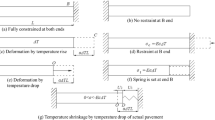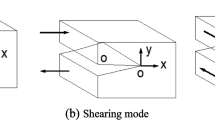Abstract
Reflective cracks in asphalt pavement are major distresses in semi-rigid pavement. To date, grouting and jointing filling are commonly used to solve this problem. However, the grouting materials cannot be filled with cracks that have not propagated to the surface of base. Thus, these measures are limited to reducing the potential cracks in the base. This paper presents a comprehensive treatment measure of base regeneration by preset cracking and grouting (BRPCG) to repair the semi-rigid pavement with severe reflective cracks. The effect of BRPCG on the crack resistance of pavement was investigated by a linear elastic model. The dynamic load and the dynamic load–temperature coupling programs were designed to obtain the mechanical responses of pavement. Furthermore, mechanical indexes based on fatigue and yield failures of pavement materials and crack coefficients were proposed to evaluate the crack resistance and safety of pavement. The results showed that the temperature difference and aging of the original pavement are two factors that should be considered when simulating the pavement structure in service. The temperature of the coupling effect has a greater influence on the tensile stress of the structure layer compared to the dynamic load. The overload conditions only increased the value of the mechanical indexes without changing the variation trend of these indexes.





















Similar content being viewed by others
References
Doh, Y.S.; Baek, S.H.; Kim, K.W.: Estimation of relative performance of reinforced overlaid asphalt concretes against reflection cracking due to bending more fracture. Constr. Build. Mater. 23, 1083–1087 (2008). https://doi.org/10.1016/j.conbuildmat.2008.09.027
Gao, Y.: Theoretical analysis of reflective cracking in asphalt pavement with semi-rigid base. Iran. J. Sci. Technol., Trans. Civil Eng. 49, 143–157 (2019). https://doi.org/10.1007/s40996-018-0154-8
Yang, Z.; Zhang, X.; Liu, X.; Guan, X.; Zhang, C.; Niu, Y.: Flexible and stretchable polyurethane/waterglass grouting material. Constr. Build. Mater. 138, 240–246 (2017). https://doi.org/10.1016/j.conbuildmat.2017.01.113
Ahn, H.J.; Lee, J.: Short-term evaluation of crack sealing and filling. Constr. Build. Mater. 113, 843–850 (2016). https://doi.org/10.1016/j.conbuildmat.2016.03.014
Pszczoła, M.; Jaczewski, M.; Szydłowski, C.; Judycki, J.; Dołżycki, B.: Evaluation of low temperature properties of rubberized asphalt mixtures. Procedia Eng. 172, 897–904 (2017). https://doi.org/10.1016/j.proeng.2017.02.098
Jaskuła, P.; Stienss, M.; Szydłowski, C.: Effect of polymer fibres reinforcement on selected properties of asphalt mixtures. Procedia Eng. 172, 441–448 (2017). https://doi.org/10.1016/j.proeng.2017.02.026
Zhu, Y.; Dave, E.V.; Rahbar-Rastegar, R.; Daniel, J.S.; Zofka, A.: Comprehensive evaluation of low-temperature fracture indices for asphalt mixtures. Road Mater Pavement Design 18, 467–490 (2017). https://doi.org/10.1080/14680629.2017.1389085
Świeczko-Żurek, B.; Jaskula, P.; Ejsmont, J.A.; Kędzierska, A.; Czajkowski, P.: Rolling resistance and tyre/road noise on rubberised asphalt pavement in Poland. Road Mater. Pavement Design 18, 151–167 (2017). https://doi.org/10.1080/14680629.2016.1159245
Ogundipe, O.M.; Thom, N.; Collop, A.: Investigation of crack resistance potential of stress absorbing membrane interlayers (SAMIs) under traffic loading. Constr. Build. Mater. 38, 658–666 (2013). https://doi.org/10.1016/j.conbuildmat.2012.08.039
Kim, K.W.; Doh, Y.S.; Lim, S.: Mode I reflection cracking resistance of strengthened asphalt concretes. Constr. Build. Mater. 13, 243–251 (1999). https://doi.org/10.1016/S0950-0618(99)00032-X
Gonzalez-Torre, I.; Calzada-Perez, M.A.; Vega-Zamanillo, A.; Castro-Fresno, D.: Evaluation of reflective cracking in pavements using a new procedure that combine loads with different frequencies. Constr. Build. Mater. 75, 368–374 (2015). https://doi.org/10.1016/j.conbuildmat.2014.11.030
Norambuena-Contreras, J.; Gonzalez-Torre, I.; Fernandez-Arnau, D.; Lopez-Riveros, C.: Mechanical damage evaluation of geosynthetics fibres used as anti-reflective cracking systems in asphalt pavements. Constr. Build. Mater. 109, 47–54 (2016). https://doi.org/10.1016/j.conbuildmat.2016.01.057
Giner, E.; Sukumar, N.; Tarancón, J.E.; Fuenmayor, F.J.: An Abaqus implementation of the extended finite element method. Eng. Fract. Mech. 76, 347–368 (2008). https://doi.org/10.1016/j.engfracmech.2008.10.015
Wang, X.; Kai, L.; Yang, Z.; Qian, X.: Investigation of thermal reflective cracking in asphalt pavement using XFEM coupled with DFLUX subroutine and FILM subroutine. Arab. J. Sci. Eng. (2018). https://doi.org/10.1007/s13369-018-3554-y
Chen, T.-L.; Zhang, L.-Y.; Zhang, D.-L.: An FEM/VOF hybrid formulation for fracture grouting modelling. Comput. Geotech. 58, 14–27 (2014). https://doi.org/10.1016/j.compgeo.2014.02.002
Bozkurt, D. Three-dimensional finite element analysis to evaluate reflective cracking potential in asphalt concrete overlays. Dissertation, University of Illinois at Urbana-Champaign (2002)
Lagos-Varas, M.; Movilla-Quesada, D.; Arenas, J.P.; Raposeiras, A.C.; Castro-Fresno, D.; Calzada-Perez, M.A.; Vega-Zamanillo, A.; Maturana, J.: Study of the mechanical behavior of asphalt mixtures using fractional rheology to model their viscoelasticity. Constr. Build. Mater. 200, 124–134 (2019). https://doi.org/10.1016/j.conbuildmat.2018.12.073
Liu, H.; Luo, R.; Lv, H.: Establishing continuous relaxation spectrum based on complex modulus tests to construct relaxation modulus master curves in compliance with linear viscoelastic theory. Constr. Build. Mater. (2018). https://doi.org/10.1016/j.conbuildmat.2017.12.204
Luo, R.; Liu, H.: Improving the accuracy of dynamic modulus master curves of asphalt mixtures constructed using uniaxial compressive creep tests. J. Mater. Civil Eng. (2017). https://doi.org/10.1061/(ASCE)MT.1943-5533.0001873
Judycki, J.: A new viscoelastic method of calculation of low-temperature thermal stresses in asphalt layers of pavements. Int. J. Pavement Eng. 19(1), 24–36 (2018). https://doi.org/10.1080/10298436.2016.1149840
Baek, J. Modeling reflective cracking development in hot-mix asphalt overlays and quantification of control techniques. Dissertation, University of Illinois at Urbana-Champaign (2010)
Dave, E.V.; Buttlar, W.G.: Thermal reflective cracking of asphalt concrete overlays. Int. J. Pavement Eng. 11, 477–488 (2010). https://doi.org/10.1080/10298430903578911
Shen, W.; Kirkner, D.J.: Thermal cracking of viscoelastic asphalt-concrete pavement. J. Eng. Mech. 127, 700–709 (2001). https://doi.org/10.1061/(ASCE)0733-9399(2001)127:7(700)
Moreno-Navarro, F.; Sol-Sánchez, M.; Rubio-Gámez, M.C.: Reuse of deconstructed tires as anti-reflective cracking mat systems in asphalt pavements. Constr. Build. Mater. 53, 182–189 (2014). https://doi.org/10.1016/j.conbuildmat.2013.11.101
Pan, P.; Wu, S.; Hu, X.; Wang, P.; Liu, Q.: Effect of freezing-thawing and ageing on thermal characteristics and mechanical properties of conductive asphalt concrete. Constr. Build. Mater. (2017). https://doi.org/10.1016/j.conbuildmat.2017.02.135
Gao, J.P.; Fan, T.T.; Ping, K.L.: Influence of freeze-thaw cycles on thermal conductivity, water permeability and mechanical properties of asphalt mixtures. Iran. J. Sci. Technol.—Trans. Civil Eng (2020). https://doi.org/10.1007/s40996-020-00491-w
Ling, Z.: Research on thermal physical parameters of asphalt mixture. Dissertation, Chang'an University (2011)
Junlong, L.: Study on dynamic modulus and crack propagation of the asphalt pavement. Dissertation, Chang'an University (2016)
Shixin, L.: Study on crack sealant interface mechanical response under the action of transient temperature field and wheel load dissertation, Harbin Institute of Technology (2015)
Rahmani, E.; Darabi, M.K.; Little, D.N.; Masad, E.A.: Constitutive modeling of coupled aging-viscoelastic response of asphalt concrete. Constr. Build. Mater. 131, 1–15 (2017). https://doi.org/10.1016/j.conbuildmat.2016.11.014
Ling, M.; Luo, X.; Gu, F.; Lytton, R.L.: Time-temperature-aging-depth shift functions for dynamic modulus master curves of asphalt mixtures. Constr. Build. Mater. 157, 943–951 (2017). https://doi.org/10.1016/j.conbuildmat.2017.09.156
Zhendong, Q.; Yuming, Y.; Tuanjie, C.; Zhan, L.: Dynamic response of asphalt pavement under moving loads with low and variable speed. J. Central South Univ. 46, 1140–1146 (2015). https://doi.org/10.11817/j.issn.1672-7207.2015.03.047
Kezhen, Y.; Xiaowen, Z.; Tingwei, S.; Jun, L.: Influence of contact form of load on mechanical index of pavement structure. J. Chongqing Jiaotong Univ. 36, 24–30 (2017)
Yin-Chuan, G.; Li-Gen, W.; Aiqin, S.; Pin-Pin, G.: Dynamic analysis of graded crushed stone as base of asphalt pavement. J. Highw. Transp. Res. Dev. 33, 27–33 (2016). https://doi.org/10.3969/j.issn.1002-0268.2016.01.005
Zuoren, Y.: Analysis of the temperature field in layered pavement system. J. Tongji Univ. 3, 76–85 (1984)
Ai, C.; Rahman, A.; Xiao, C.; Yang, E.; Qiu, Y.: Analysis of measured strain response of asphalt pavements and relevant prediction models. Int. J. Pavement Eng. 18, 1089–1097 (2016). https://doi.org/10.1080/10298436.2016.1149836
Sulejmani, P.; Said, S.; Agardh, S.; Ahmed, A.: Impact of temperature and moisture on the tensile strain of asphalt concrete layers. Int. J. Pavement Eng. (2020). https://doi.org/10.1080/10298436.2020.1715404
Hou, Y.; Ji, X.; Su, X.: Mechanical properties and strength criteria of cement-stabilised recycled concrete aggregate. Int. J. Pavement Eng. 20, 1–10 (2017). https://doi.org/10.1080/10298436.2017.1293266
Xinhe, O.; Youyun, L.; Peihong, L.; Lei, L.: Study on splitting tensile strength about asphalt mixtures with different diameter aggregates. Highw. Eng. 43, 300–304 (2018). https://doi.org/10.3969/j.issn.1674-0610.2018.05.058
Gang, W.; Li-Ping, L.; Li-Jun, S.: Research on shearing and compressive resilient modulus experiment of asphalt concrete. J. Build. Mater. 15, 279–282 (2012). https://doi.org/10.3969/j.issn.1007-9629.2012.02.026
Feng, L.; Li-Jun, S.: Analysis of the influence of base course modulus on the mechanics performance of asphalt pavement. J. Highw. Transp. Res. Dev. 23, 41–43 (2006). https://doi.org/10.3969/j.issn.1002-0268.2006.10.010
Minjiang, Z.; Yan, S.; Juan, D.: The influences of surface shear stress peak value of semi-rigid base course asphalt pavement structure. J. Shenyang Jianzhu Univ. (2007). https://doi.org/10.3321/j.issn:1671-2021.2007.02.003
Acknowledgements
The authors thank all the reviewers of this paper for their comments and suggestions.
Funding
This study was funded by the National Natural Science Foundation of China (Grant No. 51778061) and the Fundamental Research Funds for the Central Universities, CHD (Grant No.300102219713).
Author information
Authors and Affiliations
Corresponding authors
Ethics declarations
Conflict of interest
The authors have no conflicts of interest to declare that are relevant to the content of this article.
Rights and permissions
About this article
Cite this article
Jiao, Z., Shen, A., Lyu, Z. et al. Research on a Treatment Measure for Base Regeneration by Preset Cracking and Grouting for Severe Reflective Cracks. Arab J Sci Eng 47, 4695–4712 (2022). https://doi.org/10.1007/s13369-021-06246-7
Received:
Accepted:
Published:
Issue Date:
DOI: https://doi.org/10.1007/s13369-021-06246-7




